Why the 2024 Honda CR-V Should Make Your Shortlist


When you’re shopping for a new car like the 2024 Honda CR-V, it’s a good idea to start with some research. You can enjoy this CUV’s car-like performance balanced against its versatile interior. Get all the key details on the Honda CR-V in this model overview.
Spotlight on the 2024 Honda CR-V
Performance
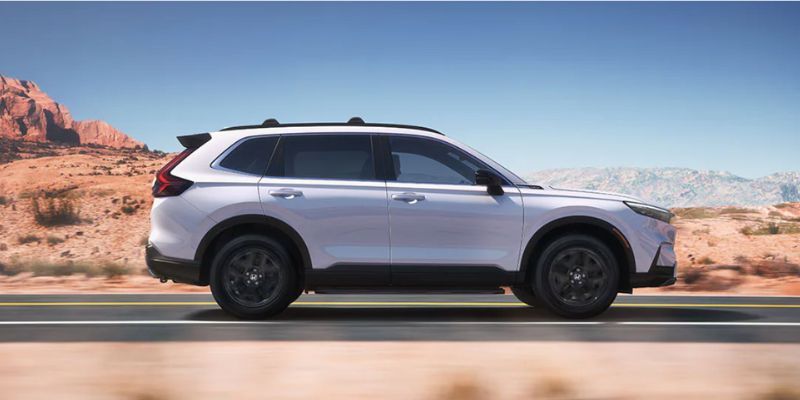
The best part of driving a new CUV is that you get a nice mix of SUV capability and sedan fuel economy. In the new CR-V, you’ll find a Turbocharger In-Line 4-Cylinder engine under the hood that can achieve an estimated 28 city / 34 highway MPG. Driving a CUV should grant you better stability and traction, and that’s just what you get when you upgrade the CR-V with all-wheel drive. Check out even more of the available performance features here:
- Dual Chrome Exhaust Finishers
- Available Real Time AWD
- Hands-Free Access Power Tailgate
Technology
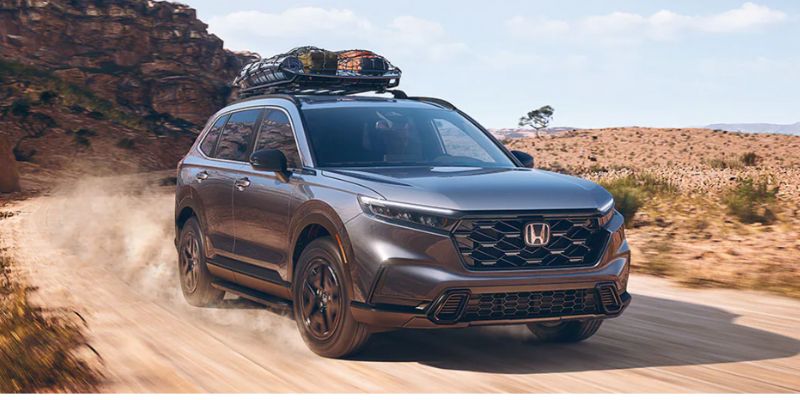
Honda knows that on today’s roads, brains are just as important — if not more important — than brawn. The CR-V is safer thanks to available safety features from Honda, designed to keep you and your passengers out of harm’s way. While the safety features stand out, the CR-V also comes with impressive options for multimedia entertainment and personal convenience. Here’s a taste of the other technology upgrades available for the CR-V:
- Available 9-inch touchscreen
- Bose Premium Sound System
- Honda Sensing Suite
Design
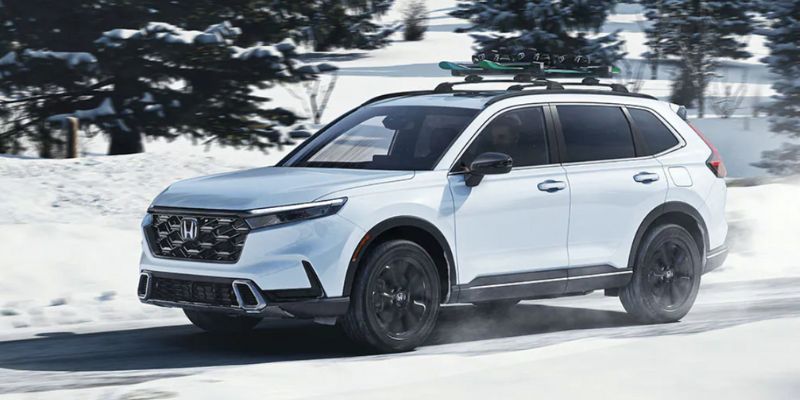
A contemporary CUV should both look and play the part. With this model, take note of the 77 cu ft with the seats folded down, plus other storage options spread around the interior. And with a rider-centric interior design, getting caught in traffic delays is a little more bearable in the new CR-V. You’ll find more available design specs of this CUV below:
- Dual-low-beam LED Highlights
- Body-Stabilizing Front Seats
- Available Gloss-Black Wheels
Get the 2024 Honda CR-V in LaGrange, GA
Come see the new CR-V in person when you visit Mike Patton Auto Family – Group Site. We feature this CUV and many more in our inventory of new Honda cars for sale in LaGrange, GA. You might also find a chance to save when you look at our new Honda specials, so check those out and schedule a test drive.
*MSRP: Starting price represents the manufacturer’s suggested retail price (MSRP) for the trim. The MSRP does not include destination and handling charges, taxes, title, license, options, and dealer charges. Actual prices are set by the dealer and may vary. Photo is for marketing and example purposes only. Photo may not reflect starting MSRP or trim level.\n**EPA-estimated MPG for City/Highway for 2024 Honda CR-V . Actual mileage will vary. Displayed MPG is based on applicable EPA mileage ratings. Use for comparison purposes only. Your actual mileage will vary, depending on how you drive and maintain your vehicle, driving conditions, battery pack age/condition (hybrid models only) and other factors.


If you’re wondering what all the buzz for the 2024 Jeep Grand Cherokee is about, you’ve come to the right place. This SUV offers the perfect marriage of curbside styling, everyday convenience, and on-road capability. Get a summary of features for the new Jeep Grand Cherokee in this model overview.
A Quick Look at the 2024 Jeep Grand Cherokee
Performance
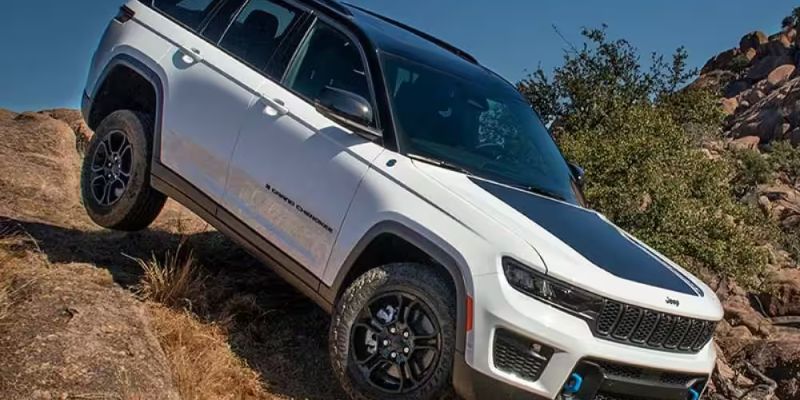
Jeep designed the new Grand Cherokee with SUV drivers in mind. It starts with the 3.6L V-6 engine, and the Grand Cherokee is able to put out a more-than-respectable 293 horsepower and a maximum towing capacity of 6200 lbs. Ride quality is smooth thanks to an optimized suspension, and you have the choice to upgrade the drivetrain. The performance features of the Grand Cherokee don’t end there. You’ll also enjoy these:
- Security system
- Electronic stability with anti-roll
- 8-speed automatic transmission
Technology
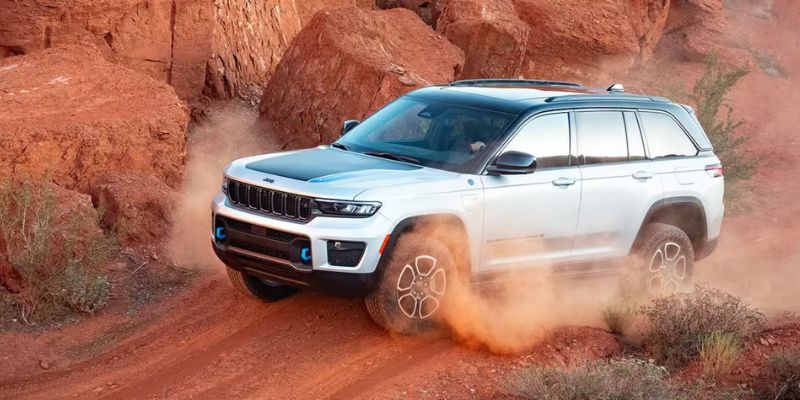
There are options aplenty for technology in the new Jeep Grand Cherokee. The Grand Cherokee is safer thanks to available safety features from Jeep, designed to keep you and your passengers out of harm’s way. Expect your fellow travelers to make the most of available multimedia features while you’re on the go. The Grand Cherokee also offers the following:
- Predictive Brake assist
- Remote keyless entry
- Voice activated audio control
Design
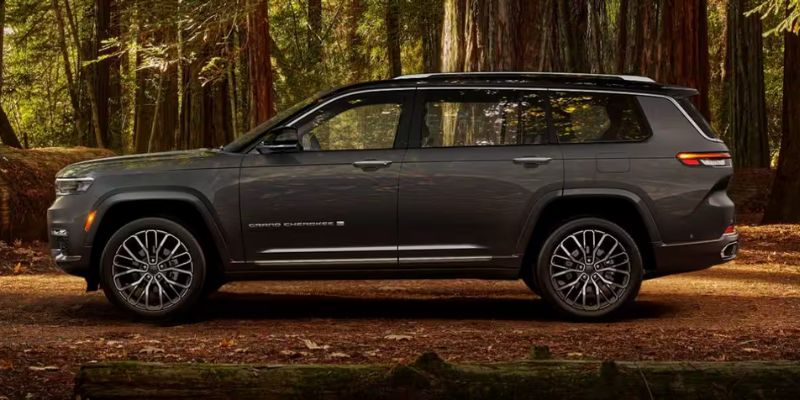
This model has a sturdy construction, memorable design, and an interior designed around efficient use of space. Everything in the cabin embodies the modern driving experience down to the 71 cu ft of cargo space. As roomy as it is visually dramatic, the Grand Cherokee is a value-oriented road companion that any commuter can appreciate. The Grand Cherokee also offers the following:
- Available Glass Sunroof
- Driver and passenger heated mirrors
- Available simulated suede/leatherette seat material
Experience the 2024 Jeep Grand Cherokee in LaGrange, GA
If you want to put the Grand Cherokee to the test, visit Mike Patton Auto Family – Group Site. All that’s left to do is select your favorite option from our inventory of new Jeep cars for sale in LaGrange, GA. Be sure to check out our new Jeep specials before you book your test drive.
*MSRP: Starting price represents the manufacturer’s suggested retail price (MSRP) for the trim. The MSRP does not include destination and handling charges, taxes, title, license, options, and dealer charges. Actual prices are set by the dealer and may vary. Photo is for marketing and example purposes only. Photo may not reflect starting MSRP or trim level.
**EPA-estimated MPG for City/Highway for 2024 Jeep Grand Cherokee . Actual mileage will vary. Displayed MPG is based on applicable EPA mileage ratings. Use for comparison purposes only. Your actual mileage will vary, depending on how you drive and maintain your vehicle, driving conditions, battery pack age/condition (hybrid models only) and other factors.
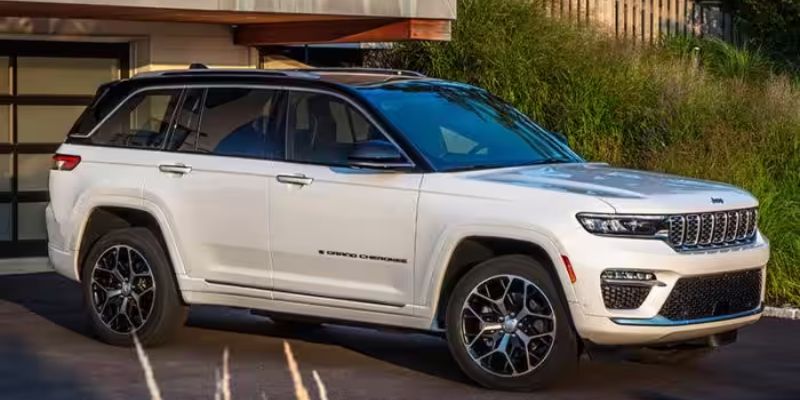

The everyday commuter. The growing family. The weekend wanderer. The 2023 Jeep Grand Cherokee offers something for all of the above. Every SUV should put you in control of the road, and that’s where the performance capabilities and tech systems of this model come into play. The best place to get a look at the new Grand Cherokee is at our dealership, but you can get all the details in this model overview.
Highlights of the 2023 Jeep Grand Cherokee
Performance
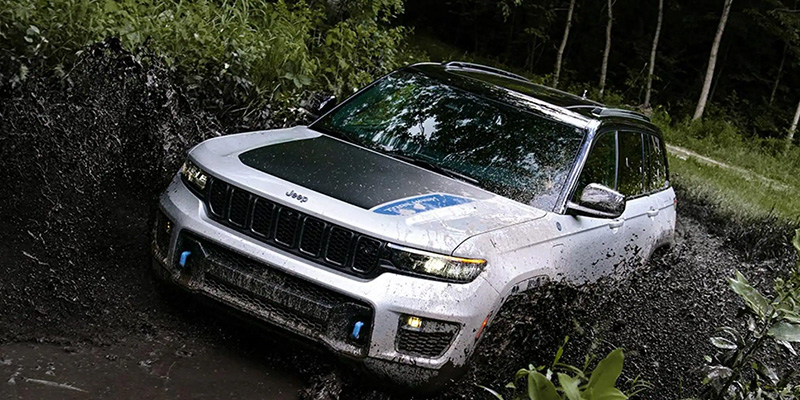
In order to hang with the big boys of the SUV class, you have to have power — and the Jeep Grand Cherokee doesn’t disappoint. For its 2023 model, the Grand Cherokee is available with a powertrain that can put out up to 293 horsepower and a maximum towing capacity of 6200 lbs. With additional drivetrain and suspension enhancements, you’re in for a smooth ride. Check out even more of the available performance features here:
- Available Class-Exclusive Quadra-Lift® Air Suspension
- Available 3.6L Pentastar® V6 engine
- Three available 4×4 systems
Technology
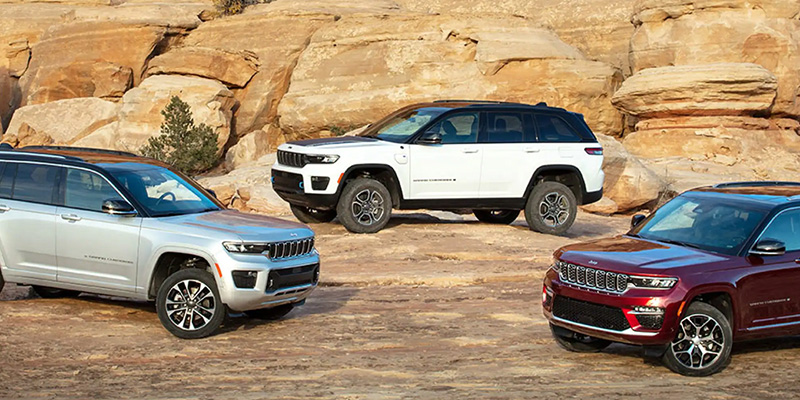
The Grand Cherokee features some of the most impressive technology currently available in a car, and as you would expect in a new SUV, much of it is focused on safety. The Grand Cherokee is safer thanks to available safety features from Jeep, designed to keep you and your passengers out of harm’s way. Add in a slew of other media, and the road is a more exciting place in the Jeep Grand Cherokee. The technology features of the Grand Cherokee don’t end there. You’ll also enjoy these:
- Active Lane Management System
- Dedicated front passenger screen
- Full-Speed Forward Collision Warning with Active Braking and Pedestrian/Cyclist Detection
Design
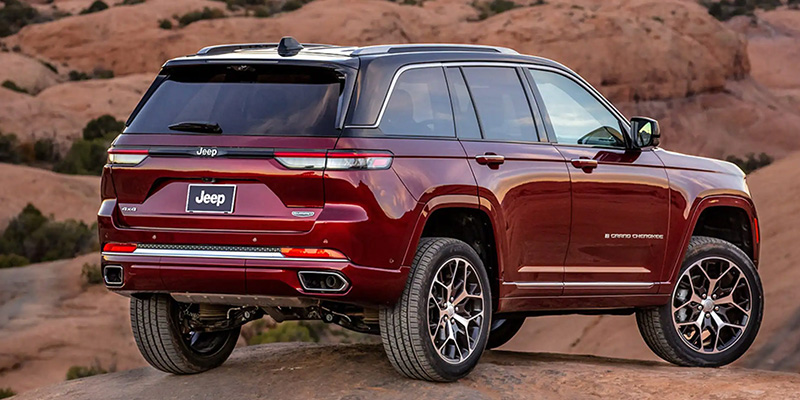
Spectacular looks are nothing new for Jeep, and neither is in-cabin utility. Load up in the spacious rear seating, or fold the seats down and pack your luggage and gear into the 71 cu ft of cargo space. Passengers will appreciate the inclusion of soft-touch materials and comfortable seating. Check out even more of the available design features here:
- Memory pre-sets and massage mode
- Available multicolor ambient LED lighting system
- Available 16-way adjustable seats
Drive the 2023 Jeep Grand Cherokee in LaGrange, GA
Visit Mike Patton Auto Family – Group Site to take a closer look at the 2023 Grand Cherokee. We can show you the features we didn’t cover here, or you can take a look at other new Jeep cars for sale in LaGrange, GA. Don’t miss our list of new Jeep specials while you’re weighing your options.
*MSRP: Starting price represents the manufacturer’s suggested retail price (MSRP) for the trim. The MSRP does not include destination and handling charges, taxes, title, license, options, and dealer charges. Actual prices are set by the dealer and may vary. Photo is for marketing and example purposes only. Photo may not reflect starting MSRP or trim level.
**EPA-estimated MPG for City/Highway for 2023 Jeep Grand Cherokee . Actual mileage will vary. Displayed MPG is based on applicable EPA mileage ratings. Use for comparison purposes only. Your actual mileage will vary, depending on how you drive and maintain your vehicle, driving conditions, battery pack age/condition (hybrid models only) and other factors.
Discover What the 2023 RAM 1500 Has to Offer
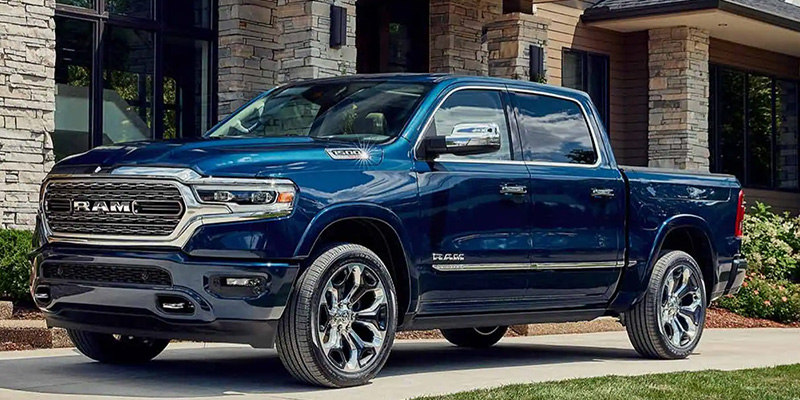

Defined by a capacious design and a unique blend of smart comfort and safety, the 2023 RAM 1500 is the truck you’ve been waiting for. It puts an unprecedented amount of control in your hands while keeping you and your passengers safe, entertained, and ready to take on the day. Don’t miss out on the best features of the new RAM 1500. Continue reading our model overview below.
The 2023 RAM 1500: Features and Specs
Performance
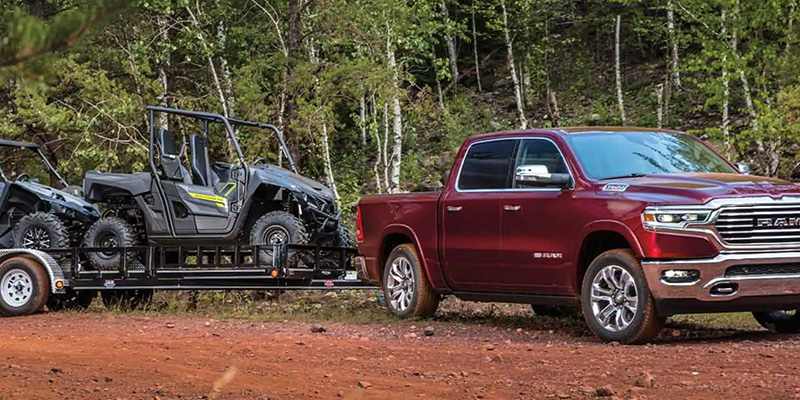
The new 1500 balances the competing demands of smooth ride delivery and powerful performance capabilities with finesse. The new 1500’s assertive powertrain features a 3.6-liter Pentastar V6 engine, and available powertrains top out at 305 horsepower and 269 ft/lbs torque, alongside an impressive towing capacity of 6,640 lbs.. RAM has matched their improvements to the 1500’s powertrain with noticeable improvements to its handling and ride quality. This model has other available performance features, including:
- eTorque Mild Hybrid Technology System
- 305hp with 273 lbs-ft torque
- 7730 lbs towing capacity
Technology
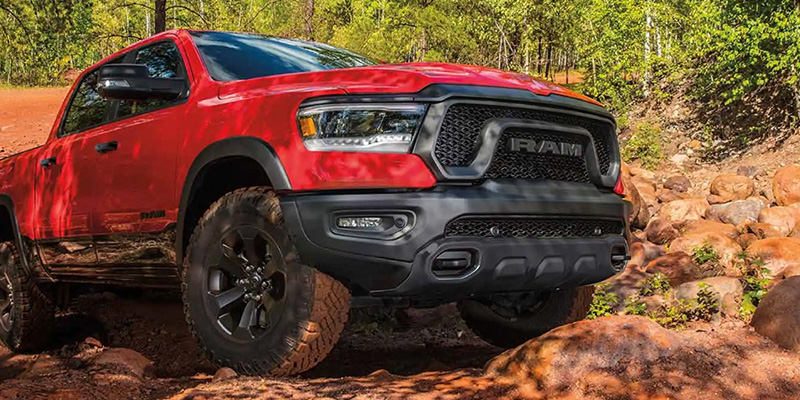
The new 1500 contains the blend of intuitive safety tech and engaging entertainment tools we expect from class-leading trucks. There are also new safety innovations from RAM that will assist you wherever you are on the road. This model completes its modern construction by offering seamless connectivity and endless entertainment via an intuitive infotainment system. Here are just a few of the features you can expect to find in this truck:
- Six airbags throughout the cabin
- Adaptive Cruise Control
- Digital rearview mirror
Design

The new 1500 feels as big on the inside as it looks from the outside. Whether you’re looking at the truck’s bed or cabin, the designers clearly prioritized one element: space. The cabin is roomy and the bed offers up to 62 cu ft of space. As spacious as it is visually pleasing, the 1500 is an achievement that any passenger can admire. The design features of this model don’t end there. You’ll also enjoy these:
- 10-square-foot dual-pane panoramic sunroof
- Multifunctional Tailgate with 60/40 split swing-away doors that can still open down
- available 900-watt, 19-speaker Harman Kardon® Premium Audio System
Find Your 1500 Trim of Choice in LaGrange, GA
At Mike Patton Auto Family – Group Site, we’re proud to list the 2023 1500 in our portfolio of vehicles. Our selection of new RAM cars for sale gives you the kind of choice you won’t find anywhere else in LaGrange, GA. Don’t forget to check our new RAM specials for current offers, and we can set up a test drive at a time that works for you.
*MSRP: Starting price represents the manufacturer’s suggested retail price (MSRP) for the trim. The MSRP does not include destination and handling charges, taxes, title, license, options, and dealer charges. Actual prices are set by the dealer and may vary. Photo is for marketing and example purposes only. Photo may not reflect starting MSRP or trim level.\n**EPA-estimated MPG for City/Highway for 2023 Ram 1500 . Actual mileage will vary. Displayed MPG is based on applicable EPA mileage ratings. Use for comparison purposes only. Your actual mileage will vary, depending on how you drive and maintain your vehicle, driving conditions, battery pack age/condition (hybrid models only) and other factors.
Discover What the 2023 Dodge Durango Has to Offer


The 2023 Dodge Durango may not know what the road holds tomorrow, but this CUV is ready for it all the same. You can expect reliable performance, smart features, and flexible cargo space in this CUV. Don’t miss out on the best features of the Dodge Durango. Continue reading our model overview below.
Previewing the 2023 Dodge Durango
Performance

Expect the best of both worlds when you’re driving a new CUV: SUV-like ride quality, sedan-like handling. In the Dodge Durango, the standard engine is a 3.6L V6 engine that lets you reach an estimated 26 MPG Hwy/19 MPG City**. Driving a CUV should grant you better stability and traction, and that’s just what you get when you upgrade the Durango with all-wheel drive. The performance features of the Durango don’t end there. You’ll also enjoy these:
- 3.6L PENTASTAR® V6
- Available 6.2L HEMI® V8
- Eight-speed automatic transmission
Technology

Forward-thinking is a mandatory trait for CUV models these days, and the new Durango is no exception. The newest model is available with the latest safety innovations from Dodge, which will help you watch the road and cover your blind spots. While the safety features stand out, the Durango also comes with impressive options for multimedia entertainment and personal convenience. The Durango also offers the following:
- Blind Spot Monitoring
- Available Adaptive Cruise Control with Stop
- Available 10.1-inch touchscreen display
Design

Dodge always designs cars that are pleasing to the eye, and the new Durango is one you’ll be proud to be seen in. With 85 cu ft of cargo space, you don’t have to be picky about what you take with you. Throw in a quiet, comfy cabin, and everybody’s busy having too much fun to ask, “Are we there yet?” For an even more comprehensive list of available design features, read this list:
- Daytime running lamps
- Available integrated wireless charging pad
- Available heated and ventilated eight-way power front seats
Get the 2023 Dodge Durango in LaGrange, GA
If you want to put the Durango to the test, visit Mike Patton Auto Family – Group Site. Our salespeople are excited to show you the new Dodge and all the other options in our portfolio of new Dodge cars for sale in LaGrange, GA. Aside from the latest and greatest Dodge models, we also offer the hottest new Dodge specials.
*MSRP: Starting price represents the manufacturer’s suggested retail price (MSRP) for the trim. The MSRP does not include destination and handling charges, taxes, title, license, options, and dealer charges. Actual prices are set by the dealer and may vary. Photo is for marketing and example purposes only. Photo may not reflect starting MSRP or trim level.
**EPA-estimated MPG for City/Highway for 2023 Dodge Durango . Actual mileage will vary. Displayed MPG is based on applicable EPA mileage ratings. Use for comparison purposes only. Your actual mileage will vary, depending on how you drive and maintain your vehicle, driving conditions, battery pack age/condition (hybrid models only) and other factors.
How Often Should You Change Your Oil Filter?

Oil is probably the most essential to the engine of your truck, car, or other automobiles. However, during circulation through the engine, oil takes up various contaminants in the form of dirt. These contaminants can damage the engine gravely and eventually lead to its death.
You might be aware of how important and how often you should change your oil, but not how important changing your oil filter is. This article will teach you how often you should change your oil filter, how to change oil filter, and what happens when your oil filter is left unchanged.
How Often Should You Change Your Oil Filter?
You might ask – what does oil filter do in car? An oil filter is a special filter designed to remove contaminants from lubricating, transmission, hydraulic, or engine oil. Their primary function is in internal-combustion engines for powered aircraft, ships and boats, motor vehicles, and stationary engines like pumps and generators. Gas turbine engines and even hydraulic machinery are also equipped with oil filters.
Returning the focus to cars, how often do you change the oil filters? To answer, you need to consider different factors. There are different engine types in cars, and they all require unique maintenance processes. For example, cars equipped with diesel engines have some differences in their maintenance pattern when compared with gasoline-engine cars.
The same is accurate for the engine capacity, technology, and quality of engine oil. The size of oil filters is another factor to consider. The reason is that oil filters with filter elements having bigger surface areas last longer.
Usually, your car owner’s manual book would be the best guide to tell you how often you should change your oil filter. Many oil and parts manufacturers would advise that you replace your oil filter every time you change oil, which usually occurs every three months or 3,000 miles (depending on which comes first).
For the newer car models, the suggested time for a change is around 6,000 miles. Older vehicles would require an oil and oil filter change more frequently than newer cars. However, it is best to refer to your vehicle handbook as it would give the most accurate time frame based on your model and make.
You should adhere to the following tips on how often to change your oil filter:
- Replace your oil filter with every car oil change.
- If you drive in harsh conditions, change your oil filter frequently.
- Your oil filter may need to be replaced if the Check Engine light appears on your dashboard.
What Happens When You Don’t Change Your Oil Filter?
For one reason, you may forget to change your old oil filter. This situation happens to many car owners, and it could happen to you too. Here are some things that happen when your oil filter is left unchanged:
- Oil will not be filtered.
- Oil will turn into sludge.
- The engine will be filled with sludge.
- The engine will get damaged and need replacement.
Oil Will Not Be Filtered
Your oil filters are designed to filter out engine oil contaminants and prevent them from getting into the engine. When your engine oil filters get old and worn, they cannot carry out this process. And if you refuse to replace them, the filters will get blocked, losing their filtering properties.
Oil Will Turn into Sludge
If you refuse to change your oil, at some point, the old oil that is no longer getting filtered will break down and turn into engine sludge. And at this point, even if you replace your oil, ensure that you replace the oil filter too. Otherwise, the new oil will not get filtered because of the congested oil filter.
The Engine Will Be Filled With Sludge
If you continue to drive your car under these conditions, contaminants and dirt will continue to accumulate inside your engine, which is terrible news for the engine. The sludge will accumulate inside your engine. And eventually, its internals will be filled with sludge. When this happens, there will be less lubrication and more friction in the engine, leading to the wearing of the engine components.
The Engine Will Get Damaged and Need Replacement
If at this point, you still haven’t got an oil and filter change, then you might have sealed the engine’s fate. Due to friction, there would be increased wear, tear, and heat which would cause the engine’s internals to lock up. At that time, you would need to spend more money replacing the engine. Therefore, it is usually better to change a minor oil filter than undergo the stress and expenses of changing your car’s engine.
How to Change an Oil Filter
For every DIY lover, we’re glad to inform you that you can perform an oil filter change independently. However, the best solution is to take your car to a repair shop. Now let’s get you started on how to change an oil filter.
Things You’ll Need
- Oil drain pan
- Socket wrench
- Mallet
- Oil filter
- Work gloves
- Filter wrench
- Motor oil
Steps to Follow
- Loosen the oil fill cap to help the oil drain more quickly.
- Put an oil drain pan beneath the oil drain plug.
- Remove the oil plug to drain out all the oil, now replace the plug.
- Locate the oil filter attached to the engine block by a metal cylinder.
- Move the oil drain pan below the oil filter.
- Unscrew the oil filter by hand or with a filter wrench.
- Leave the old filter in the oil pan and let it drain for about 24 hours.
- Use motor oil to lubricate the gasket on the new oil filter.
- Use your hand to screw the filter till it makes contact with the engine block.
- Tighten the new filter.
- Finally, refill the engine with fresh motor oil.
Conclusion
Oil filters are highly essential for your car. They ensure the smooth running of your car, improving efficiency and performance. You should pay as much attention to your oil filters as you pay to your engine oil. For further inquiries, you can visit our website at Mike Patton Auto Group. We are experts in all car dealings, and you can also contact us for your oil change services.
The cabin air filter is integral to the vehicle heating and cooling system. Most people ignore it because it does not directly affect the car’s movement. However, this is dangerous as it can cause health implications, offensive odor, etc. This article explains everything you need to know about the cabin air filter including how to clean it.
What Is a Cabin Air Filter?
An air filter is a pleated unit of paper-based, multi-fiber cotton material. Before air can flow into the interior of a vehicle, it first goes through the filter and blocks any pollution within the air to prevent it from penetrating the air you breathe. It’s often located behind the glovebox or under the hood and cleans the air as it moves through the car’s heating, ventilation, and air conditioning(HVAC) system.
If you’re suffering from an asthmatic condition, allergies, or other health conditions that affect respiratory health, you should be careful of the air you breathe. This is because polluted hair is a detriment to such health conditions.
To counter this, most modern vehicle models manufacture cabin air filters to catch contaminants and airborne materials that can create unpleasant and hazardous air for you. After some time, if you perceive an unpleasant odor in your car or a decreased airflow, you should consider changing your cabin filter to enhance the safety of the air in your car.
Disadvantages of a Damaged Cabin Air Filter
Driving with a damaged car cabin air filter has a lot of disadvantages. It poses a threat to our health and the car system. Below are severe dangers attached to a damaged air filter.
The HVAC System Won’t Function Properly
An overused cabin air filter will harm how the HVAC system functions. And this can cause your vehicle to overheat, resulting in a burn-up. A dirty cabin air filter will also reduce the air flowing from the AC vents, heater core, or evaporator. So, if you notice anything wrong with your HVAC system, try checking your air filter. It could be the problem.
Health Implications
It is important that we drive with a good air filter. This is because a clogged or dirty cabin air filter won’t filter those pollutants. It would make the air unsafe to Inhale, thereby causing difficulties for people with or without allergies or health conditions.
Offensive Odor
If you perceive a foul odor from your vents, you should try to change the cabin air filter. An excessively clogged air filter produces a dusty, irritating odor, especially with the HVAC turned on.
Bad Window Fog Clearing
Another danger of a bad cabin air filter is that the windshield won’t clear the fog quickly. A faulty cabin air filter creates condensation on the windshield. This is dangerous, especially during winter and fall seasons. However, this can be solved by replacing or cleaning your cabin air filter.
Signs I Need to Change My Cabin Air Filter
Most people don’t know when to change the cabin air filter of their cars. Therefore, manufacturers specify the time to change it according to the vehicle’s model. Some air filters must be changed every 15,000 miles while others need to be changed every 25000-30000 miles. So, you can go through your vehicle’s manual to confirm yours.
However, if you’ve misplaced the manual and have no idea how to go about it, you should pay attention to the signs below.
- Excessive loud noise when the heating or cooling system is in use.
- Poor running of the HVAC system even when it’s set to the highest. That is, there will be weak or unstable airflow.
- Unpleasant odors from the vehicle vents.
- Shrieking sounds coming from the cabin air intake ducts.
- Icy or Foggy windows with difficulties in cleaning.
Sometimes, the area where you drive can contribute to a faulty air filter. If you continuously drive in an urban clogged area with poor airflow quality, you might need to change your air filter frequently. A place with a desert climate can also get your filter clogged with dust.
Cost of a Cabin Air Filter
The cost of a cabin air filter is relative to the model of the car. Vehicles with higher specifications are more expensive than vehicles with low or average specifications. However, the average cost for a cabin air filter is between $15 and $25.
How to Change Cabin Air Filter
As stated earlier, the cabin air filter is located behind the glove box, beneath the dashboard, or under the hood. If it’s behind the glovebox, then there’s a high probability that you can fix it by removing the glovebox from the fasteners that hold it down. Also, your vehicle owner manual can guide you on removing the glove box.
However, it might not be easy to access if your cabin air filter is located under the hood or beneath the dashboard. In cases like this, you can contact a mechanic for help.
Also, if you are getting your car serviced, demand to see the cabin air filter before replacing it. If it’s not dirty or clogged or doesn’t smell bad, then you can wait.
How to Clean Cabin Air Filter?
Of course, you can clean some cabin air filters, which are reusable. But you cannot use them in a vehicle with an HVAC system. The first thing to do while cleaning is to set your hose on low pressure, then rinse from side to side, and top to bottom. After that, fill a container with soapy water, drown the filter in the soap water and soak for about 10 minutes. Repeat this in clean soap water if needed. Rinse, dry with a towel, and keep it under the sun.
Conclusion
If you detect any of the above signs in your cabin air filter, you should fix it immediately. Remember, driving with a damaged air filter is dangerous to your health and the rest of your system. If you need help on how to change air filter in car, or other car services, you are at the right place. At Mike Patton Auto, our group of competent workers will solve your car problems. Visit our website to schedule an appointment with us today.
5 Car Noises: What They Mean & If You Should Worry?

Key Takeaways
- Engine damage or problems can create unusual sounds that cause great worry.
- All car owners should know the distinct engine sounds that cause alarm and warrant a visit to the dealership.
- The winters are especially popular for testing your engine’s durability. You might face significant engine issues during the period.
- Regardless of the unusual car sounds and problems, having a reliable auto technician behind your back makes all car woes manageable.
Yes, your car has a personality. And just like with people, each one has different quirks and noises that come along with it. But what do these sounds mean? Should you be worried when your engine starts rattling?
Keep reading as we discuss unusual car noises and what they might indicate about your vehicle’s health. As a bonus, we’ll also share tips on how to deal with unusual car engine sounds if necessary.
So, pull up a chair & learn all about car maintenance! You never know; it just might save you from a costly repair bill down the road.
Car Engine Noises that Could Mean Trouble
Some engine sounds indicate more trouble than others. So, if you hear any of the following five noises from your car’s engine, it might be time to take it in for a tune-up.
- Hissing or Sizzling
A loud hissing or sizzling sound is never cool; it is usually an indication of a coolant leak from the radiator or one of the engine hoses. Coolant is essential for keeping your engine at the proper temperature, so if there’s a leak, an auto technician needs to take a look as soon as possible. An overheating engine can spell disaster for your car and possibly leave you stranded on a busy freeway. Please don’t wait for the hissing sound to disappear; it won’t; get it checked immediately.
Also, Learn – The Difference Between a Coolant and Antifreeze
- Clanking or Knocking
A clanking or knocking noise often indicates a problem with the connecting rods or bearings. This serious issue should be addressed by a qualified mechanic as soon as possible.
- Squealing
If your car’s engine starts squealing when you switch on the ignition, it could indicate that the serpentine belt needs replacement. The serpentine belt powers various car components, such as the alternator, water pump, and power steering pump.
- The Knocking Noise
Low or dirty oil levels produce an ungainly knocking noise that you should not ignore. Check the oil level and quality and if necessary, add more oil or have the oil changed by a mechanic. Continuing to drive with low or dirty oil can cause severe damage to the engine, as your ride’s already begging for a visit to the technician.
- The Humming Noise
Your car’s not auditioning for the American Idol; if you hear that humming noise when you put the pedal to the metal, it’s because the wheel has loose bearings. Wheel bearings are essential in keeping your wheels spinning smoothly, so if they’re worn out, you’ll need to replace them.
Car engine noises can be annoying, but some of them can also indicate that there is trouble brewing under the hood. If your car starts making any of these five noises, take note and take action accordingly to avoid further damage.
How the Winter Can Cause Your Engine to Make Unusual Noises?
Whether it’s a squeak, a rattle, or something else entirely, engine noises during the winter can be cause for alarm—or at the very least, a visit to your mechanic. But why does this happen, and should you be worried?
The first thing to understand is that cold weather can profoundly affect your car’s engine. When the temperature drops, your engine’s metal components contract, creating all sorts of strange noises. Winter weather also leads to condensation buildup inside the engine, further contributing to those annoying noises.
So, should you be worried if your car starts making strange noises during the winter? The answer is yes and no. If the noise is something you’ve never heard before or if it’s accompanied by other strange symptoms (like decreased performance or increased fuel consumption), then it’s worth taking your car to a qualified mechanic for a checkup.
However, if the noise is something you’ve heard before and it doesn’t seem to be affecting your car’s performance, then it’s probably…. another thing to worry about, never take engine noises for granted and schedule a maintenance check with a reliable auto technician.

Diagnosing Engine Noises – Steps Auto Technicians Take
Before you visit the auto-technician, a simple DIY inspection can reveal important details about the source of engine noise. Here are a few steps you can follow:
Step One: Identify the Type of Noise You’re Hearing
Is the noise a knocking sound? A hissing sound? A clicking sound? Or something else entirely? Identifying the type of noise can be a useful starting point in diagnosing the problem.
Step Two: Listen for Where the Noise is Coming From
Is the noise coming from the front of the engine? The back? The side? Narrowing down the location can also help pinpoint the problem.
Step Three: Compare the Noise to Other Sounds You Know
Does the noise sound like anything else you know? Try to compare it to other noises you’ve heard before (either in real life or in movies/television) to see if that gives you any clues.
Step Four: Take Your Car for a Test Drive
Once you’ve done the above, it’s time for a test drive. Pay attention to when the noise is happening and see if you can reproduce it under different conditions. The more information you have, the better equipped you’ll be to diagnose the problem.
Unwanted car noises are never fun. But fortunately, most of the time, they do not cause alarm. If you’re ever unsure about a noise your car is making, bring it to us, and we’ll take a listen.
Mike Patton Auto Group, serving Lone Oak, GA, can help decipher what the problem may be and whether it needs detailed repair or maintenance. After all, that’s what we’re here for!
Schedule a service with us today, and let us help you eliminate any unwanted car noises.

Key Takeaways:
- A little planning may help to get a better return on your automobile.
- Dents, scratches, and other blemishes can depreciate a vehicle’s resale value.
- Additionally, driving safely may help keep your automobile’s value high over time.
- Premium models and SUVs tend to retain their value high.
- White or silver colors have better resale value.
- Avoid rusting by regularly washing and waxing your car.
- Be sure to keep up with scheduled tune-ups to maintain the longevity of your car.
- Mike Patton Auto Group offers car maintenance and repair services to customers in Hogansville, GA, and the surrounding areas.
It’s no secret that maintaining your car in good condition can help to retain its resale value down the line. But where to start – especially when it comes to those little details that can make a big difference. Mike Patton Auto Group has put together a list of fourteen tips for you to follow to ensure your car holds its value and doesn’t end up on the chopping block prematurely. Keep reading for all the info!
14 Tips for Retaining Your Car’s Resale Value
Follow these fourteen suggestions to get the highest refund when selling your automobile.
1. Regular Cleaning
Making a habit of frequent car cleaning from the inside out is essential to retain its resale value. It will protect the finish from damage caused by dirt, pollen, and other debris. Additionally, be sure to wash off any salt or chemicals that could potentially corrode the bodywork.
2. Avoid Dings and Scratches
Another way to keep your car looking new is to avoid those pesky little dings and scratches. Park it in well-lit areas and away from trees, bushes, and other potential hazards. And if you find yourself with a minor blemish on your paintwork, be sure to touch it up as soon as possible – otherwise, it could rust or lead to further damage down the line.
3. Regular Car Servicing
Regular car servicing is also essential. It means regularly checking the oil, tire pressure, and other fluid levels. It will help prevent breakdowns and ensure that your car runs as efficiently as possible, saving you money in the long run.
4. Avoid Accidents
Of course, avoiding accidents is one of the best ways to retain your car’s resale value. Drive carefully and be mindful of your surroundings. If you have an accident, make sure you get it repaired professionally, so there’s no lasting damage.
5. Choose the Right Model
When buying a vehicle, please choose a model with a solid reputation for keeping its value. Some models have much demand on the market and retain their value better than others, so it’s worth doing your homework before purchasing. In general, premium automobiles and SUVs tend to keep their weight better than economy cars.
6. Don’t Modify Your Car
To retain your car’s resale value, it’s best to avoid any modification. It includes adding aftermarket parts or painting the exterior. These modifications can lower your car’s resale value, so try not to do them if possible.
Choosing carefully while customizing your car is critical since some modifications may lower the value of your automobile. Installing a raucous music system or adding massive spoilers, for example, may make your vehicle less appealing to potential purchasers searching for a quieter car.
7. Maintain Your Car Records
Buyers will likely pay more for your car if you provide routine maintenance and repair records. These documents will illustrate to potential buyers how well you have treated the vehicle, making it easier for them to trust that the car has been taken care of.
Knowing the car’s history is crucial when selling your used vehicle. It covers things like whether it has ever been in an accident or if any mechanical problems need to be addressed. Although Carfax covers that aspect, you should have your own history in the form of receipts & cards to better corroborate your service records. The more information you have about your automobile’s past, the easier it will be to sell it at a higher price.
8. Avoid Rust
Rust slowly eats away any vehicle’s exterior and interior over time. Therefore, take precautionary measures to avoid rust and its destructive effects. If you live in a cold area with harsh winters, wash your car regularly to remove salt deposits that may cause rust.
You can also undercoat your vehicle with a rust-proof spray to prevent salt deposits from accumulating on the frame and underside of the quarter panels and fenders. People can also purchase commercial jets that protect their automobiles throughout the year.
9. Drive Carefully
The way you handle your car on the road has a direct effect on its worth. By driving smoothly, without quick starts and stops or hard corners, you can make your car’s engine and brakes last longer. It will keep its resale value high. In addition, careful driving prevents accidents, which often substantially damage a vehicle and devalue it instantly.
Also, check out our blog on safe driving in torrential rain to protect your car from water damage.
10. Choose Your Color Carefully
If you’re trying to pick a color for your new car that will help retain its value, stick with white or silver. Popular colors tend to hold their value better than other colors, like red or yellow.

11. Get Regular Inspections
Regular maintenance is vital to keep your car’s value high, but another way to do this is by getting regular inspections. It means taking your vehicle in for a checkup every few months to ensure everything is working correctly. You’ll also save money over time by catching any potential problems early on.
12. Store It Properly
If you don’t plan on driving your car for a while, store it properly to retain its resale value. It means keeping it in a garage or covered parking spot as much as possible because exposure to the elements can cause damage that will reduce the value of your vehicle.
13. Don’t Smoke
If you smoke, avoid smoking in your car since the smoke may discolor the upholstery and leave a distinct odor. If you must smoke in your automobile, open the windows before shutting them to allow the smoke to go out.
14. Sell It at the Right Time
Timing is crucial to receive the optimal amount of money for your car. Automobiles tend to devalue rapidly in the initial years after purchase, so selling sooner rather than later will likely result in a better return.
Need Car Maintenance Services in Hogansville, GA? No Problem!
At Mike Patton Auto Group, serving Hogansville, GA, we know your time is essential. That’s why we offer online scheduling for our car maintenance services. Plus, we’re qualified and experienced in servicing all vehicle makes and models. So, don’t hesitate to contact us today or browse our website to learn more about what we can do for you!
Radiator News: Antifreeze Vs. Coolant

Key Takeaways:
- Antifreeze prevents an engine from freezing in cold weather, while coolant is used to keep an engine from overheating.
- An ideal coolant typically contains 50% antifreeze and 50% water. The right proportion depends on the climate.
- Suppose you notice any signs of engine overheating. In that case, it’s best to consult a professional mechanic to have your car checked and topped off.
- Never try to concoct a coolant-antifreeze ratios unless supervised by an auto mechanic!
Keeping your automobile’s engine cool is critical, and there are many options on the market. The two most popular car radiator fluids are coolant and antifreeze. Both the fluids perform the same function, i.e., keeping the temperature of your engine stable. But what’s the difference between these two? We’ve put together a quick guide!
Antifreeze is a radiator fluid added to the water in your car’s cooling system to keep the engine from freezing during cold weather. It also helps to keep the vehicle’s engine from overheating during hot weather. Coolant is simply a mixture of antifreeze and water.
But it’s not that simple – there are many other things that you need to know about the two cooling fluids!
Read: Is coolant the same as antifreeze?
The Key Differences Between Coolant and Antifreeze
Water Content
Coolant always has water, while antifreeze may or may not have water. Some types of antifreeze are made of glycols, chemicals that prevent freezing and overheating.
Most coolants are a mixture of water & antifreeze, but most antifreeze contains little to no water.
Fluid Color
Antifreeze has a sweet smell, while coolant typically has a more bitter odor. It’s usually green, red, or yellow, while coolant can be any color. The color doesn’t affect how the fluid works but can help you tell them apart. Coolant is often dyed blue or orange.
While you can mix different coolant colors, it’s generally not recommended as it can make it difficult to tell if the mixture is still effective.
Function
The main difference between coolant and antifreeze is that coolant is used to keep the engine cool, while antifreeze prevents the engine from overheating. Antifreeze also raises the coolant’s boiling point, which helps prevent the engine from overheating.
Boiling Point
The boiling point of the engine coolant is lower than the boiling point of antifreeze. This is because coolant contains water with a lower boiling point than glycols. The boiling point of antifreeze is higher than the boiling point of coolant because it doesn’t contain water.
Freezing Point
Water freezes at around 32 degrees Fahrenheit (0 degrees Celsius). But when you add antifreeze to water, the freezing point goes down. That’s important because if the coolant freezes, it can crack the engine block or radiator.
Price
Antifreeze is usually more expensive than coolant because it lasts longer and provides better protection against both freezing and overheating.
Pro Tip: You should never mix coolant and antifreeze without expert opinion because they perform different functions and have different chemical compositions. Mixing the two in the right proportions is very important. Not doing so can cause your engine to overheat or freeze.
How Do the Antifreeze and Coolant Work Together to Keep Your Engine Cool?
The radiator draws heat away from the engine using coolant. The coolant then travels through a series of hoses to the radiator, cooled by air flowing over it. The cooled coolant then flows back to the engine, where the cycle restarts.
In hot weather, the thermostat opens to allow more coolant to flow through the system, and in cold weather, it closes to prevent the coolant from cooling too much and freezing.
Antifreeze lowers the ice point of water so it can circulate through the system even in very cold temperatures without freezing and damaging the engine. It also raises the water’s boiling point so it can circulate through the system at higher temperatures without boiling and creating steam. Additionally, it contains corrosion inhibitors to protect the engine from rust and other forms of corrosion.
Check your owner’s manual for specific replacement intervals, as they can vary depending on the make & model of your vehicle.
What’s The Right Proportion of Antifreeze in Coolant?
An ideal coolant typically contains 50% antifreeze and 50% water. The right proportion of antifreeze in the car coolant will depend on the climate.
A higher concentration of antifreeze is needed in colder climates to prevent the coolant from freezing.
In warmer climates, a lower concentration of antifreeze is typically used to prevent the coolant from overheating.
The best way to determine the right proportion for your car is to consult your owner’s manual or a professional mechanic.
Signs of Low Coolant
Here are a few signs that you may need to add more antifreeze to your coolant.
- If your engine is overheating, this could indicate that the coolant level is low and needs to be replenished.
- If you notice any leaks from under your car’s hood, your coolant may be leaking.
- If your car’s radiator or hoses feel hot to the touch, this could be another sign that the coolant level is low.
- Another sign of low coolant levels is if the temperature gauge on your dashboard is reading higher than usual.
- You may also notice steam from under your car’s hood, indicating that the coolant is boiling and needs replenishment.
Suppose you’ve started noticing any odd signs. In that case, it’s best to consult a professional mechanic to have your car checked and topped off with the appropriate amount of antifreeze.
Read: How to tell if your car radiator needs replacing?
Conclusion
In conclusion, knowing the difference between coolant and antifreeze is important. Coolant is a liquid that helps to keep your car’s engine cool, while antifreeze is a chemical added to the coolant to help protect your car’s engine from freezing or overheating. If you notice any signs that your car’s cooling system is not working properly, be sure to consult a professional mechanic to have it checked out. Thanks for reading!
At Mike Patton Auto Group, we know that keeping your car in good condition is important to you. That’s why we offer a wide range of services, from oil changes to coolant flushes. Our highly trained technicians will take care of your car as if it were their own, and they’ll make sure to get the job done right the first time. We know your time is valuable, so we offer convenient appointment times and a comfortable waiting area with complimentary refreshments. So, whether you need a simple tune-up or a major repair, you can count on Mike Patton Auto Group to get the job done right.



